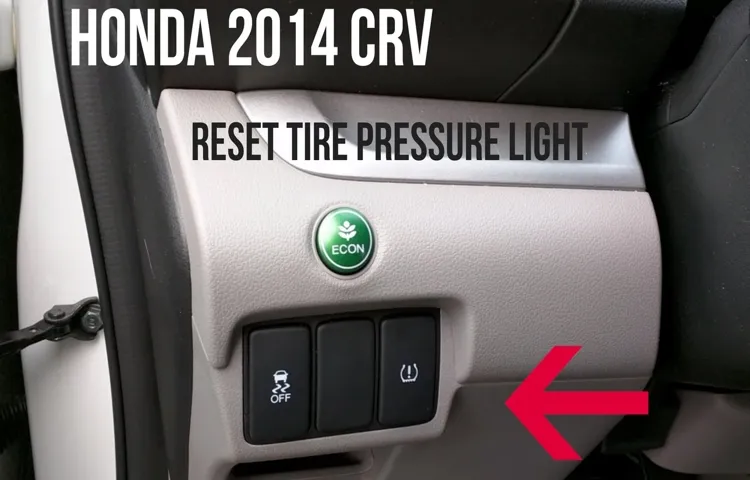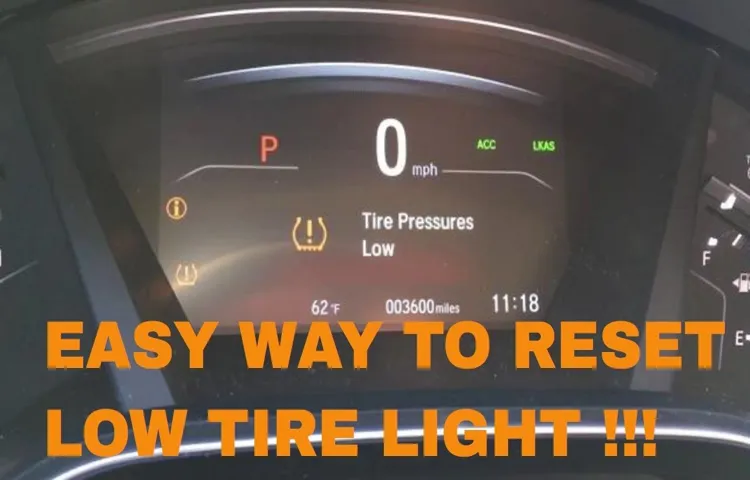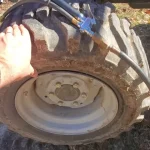Is it time to check the tire pressure on your Honda CRV 2022? It’s a crucial aspect of car maintenance that is essential to ensure safety while driving and get the most out of your car’s performance. But do you know how to do it correctly? Luckily, checking your tire pressure is a simple process that takes only a few minutes. All you need is a tire pressure gauge, which can be purchased at any auto parts store, and access to your CRV’s tires.
First, ensure that your tires are cold or have not been driven for several hours. Then locate the tire pressure information label, usually found on the driver’s side door jamb. The label provides the manufacturer’s recommended tire pressure for your car.
Now it’s time to get your tire pressure gauge and remove the valve cap from one of the tires. Place the gauge over the valve stem and press down firmly. The gauge will display the current tire pressure.
Compare the reading to the recommended tire pressure on the label. If the reading is low, use an air compressor and inflate the tire to the recommended level. If the reading is high, use the gauge to release some air until it reaches the recommended pressure.
Repeat the process for all four tires, and don’t forget to replace the valve caps when you’re finished. Checking your CRV’s tire pressure regularly will extend the life of your tires, improve fuel efficiency, and ensure safer handling on the road.
Table of Contents
Why Checking Your Tire Pressure is Important
If you just bought a 2022 Honda CR-V, one of the important things you need to know is how to check tire pressure. Doing so is crucial for both safety and fuel efficiency reasons. Properly inflated tires ensure that your vehicle can handle well while driving on the road.
They also help extend the lifespan of your tires and improve fuel economy, which can save you money in the long run. Checking your tire pressure is easy–simply use a tire pressure gauge and locate the recommended pressure in your vehicle’s owner manual. It’s recommended to check your tire pressure once a month, or before long trips.
By making it a regular habit, you can ensure your Honda CR-V is running smoothly and efficiently.
Prevent Tire Damage and Blowouts
Maintaining appropriate tire pressure is essential for the longevity of your tires and to avoid tire damage that can cause blowouts. Why is it important to check your tire pressure regularly, you may ask? Overly inflated or under-inflated tires can lead to uneven wear and tear, reducing their lifespan, and affecting drive quality. Low tire pressure means that more of the tire is in contact with the road, leading to increased friction, heat buildup, and internal damage.
On the other hand, overinflated tires have a smaller contact area with the road, resulting in a harsher ride, reduced handling stability, and susceptibility to wear and leaks. Moreover, suboptimal tire pressure means that the vehicle consumes more fuel than usual, making it less efficient and more expensive to run. Therefore, checking your tire pressure frequently can help you to prevent tire damage, increase safety, improve fuel efficiency, and save a lot of money in the long run.

Improve Fuel Efficiency
Tire pressure is often overlooked as an important aspect of maintaining and improving fuel efficiency. When your tire pressure is low, your tires have to work harder to keep your vehicle moving, reducing your gas mileage and costing you more money at the gas pump. But this isn’t the only reason to regularly check your tire pressure.
Driving on underinflated tires also puts you at a greater risk for blowouts and puts unnecessary stress on your vehicle’s suspension and steering systems. By keeping your tires properly inflated, not only will you save money on gas, but you’ll also keep yourself and your passengers safe on the road. So, before you hit the road, take a few minutes to check your tire pressure—the small effort can go a long way for both your wallet and your safety.
When and How Often to Check Tire Pressure on Honda CRV 2022
If you’re wondering how often you should check the tire pressure on your Honda CRV 2022, the answer is simple: you should check it at least once a month or whenever you notice a change in handling or noise levels. Checking tire pressure is crucial for maintaining proper handling and maximizing fuel efficiency, but it’s often overlooked by many drivers. To check your tire pressure, you’ll need a tire pressure gauge (which you can find at any auto parts store) and access to your vehicle’s recommended tire pressure levels (which can be found in the owner’s manual or on a label inside the driver’s side door jamb).
Simply unscrew the valve cap and place the gauge on the valve stem, pressing firmly until you hear a hissing sound (which indicates that you’re getting an accurate reading). Compare the reading to the recommended pressure levels, and if the pressure is too low or too high, adjust it as needed. By keeping your tires properly inflated, you’ll not only save money on gas but also extend the life of your tires.
So, don’t forget to check your tire pressure regularly!
Check Monthly and Before Long Trips
Tire Pressure on Honda CRV 2022 If you’ve just purchased a Honda CRV 2022 or you’re a seasoned owner, keeping your tires in good condition is critical. Tire pressure is the most important factor in maintaining your vehicle’s safety and fuel efficiency. Experts recommend checking tire pressure at least once a month or before long trips.
The ideal tire pressure for Honda CRV 2022 can vary depending on the size of the tires, but it should be listed in your owner’s manual or on a sticker on the driver’s side door. In addition to checking the tire pressure, it’s important to inspect your tires for wear and damage. Look for signs of uneven wear, such as bald spots or cracks, which can indicate a problem with your alignment or suspension.
If you notice any damage or wear, it’s best to have a professional inspect your tires to ensure your vehicle is safe to drive. Keeping your tires at the right pressure and in good condition is essential for a smooth and safe driving experience. So, make sure to check your tire pressure regularly and before heading out on any long trips.
Check When Tires are Cold
One of the most critical aspects of maintaining your Honda CRV’s performance is routinely checking its tire pressure. As a general rule, you should check your CRV’s tire pressure at least once a month, especially during cold weather conditions. Checking your tire pressure when the tires are cold is important as it provides an accurate reading of the tire pressure.
When the tires are warm, the air inside them expands and gives a false reading. An incorrect tire pressure can affect your CRV’s fuel efficiency, handling, and overall safety. Therefore, it is essential to keep your tires adequately inflated, as recommended by the manufacturer.
A good way to keep track of your CRV’s tire pressure is to invest in a digital tire pressure gauge. Not only is it easy to use, but it also provides accurate measurements. With proper and regular maintenance of your CRV’s tires, you can ensure a smoother driving experience while also extending the life of your tires.
Steps to Check the Tire Pressure on Honda CRV 2022
Are you wondering how to check the tire pressure on your new Honda CRV 2022? Here are some simple steps to help you maintain your vehicle’s performance and safety. First, you need to make sure that you have a reliable digital or analog tire pressure gauge. Then, locate the valve stem on the tire and remove the cap carefully.
Next, press the gauge onto the valve stem firmly to get a reading. Compare the reading with the recommended tire pressure in your vehicle’s owner manual. If the pressure is too low, use an air compressor to inflate the tire to the correct pressure level, and if it’s too high, let some air out until you reach the ideal level.
Remember to check all four tires and the spare tire regularly, especially before long trips or in extreme weather conditions. By following these simple steps, you can ensure that your Honda CRV 2022 performs at its best, providing a smooth and safe driving experience.
Gather the Tools You Need
If you’re looking to check the tire pressure on your newly acquired Honda CRV 2022, there are a few tools you’ll need before getting started. First and foremost, you’ll need a tire pressure gauge to accurately measure the tire pressure. Next, you’ll need a source of air to refill the tires if necessary, such as an air compressor or a gas station pump.
Additionally, it’s a good idea to have a tire inflator on hand in case you need to add air while on the go. Once you’ve gathered these tools, you’re ready to move on to the steps for checking the tire pressure on your Honda CRV 2022 and ensuring optimal driving performance. By taking the time to maintain your tire pressure, you’ll increase fuel efficiency and prolong the life of your tires, ultimately saving you time and money in the long run.
Locate the Tire Pressure Monitoring System
As a new owner of a Honda CR-V 2022, it is essential to check the tire pressure regularly. Not only it ensures optimal safety and handling, but it also enhances fuel efficiency. To start, locate the tire pressure monitoring system (TPMS) button, which is usually positioned at the driver’s side as seen on the dashboard.
It may vary depending on the vehicle’s year, make, and model, but it should be easily accessible. Once you locate it, turn the ignition to the “On” position without starting the engine. Press and hold the TPMS button until the indicator light flashes, indicating that the vehicle is in TPMS mode.
Check each tire’s pressure using a tire pressure gauge, which should be within the range indicated in the owner’s manual or on the door jamb. If you find any tire under-inflated, add air as necessary, and check the pressure again until it reaches the recommended level. Repeat the process for all the tires, including the spare tire.
Always remember to reset the TPMS button to exit the TPMS mode once done. By following these simple steps, you can ensure that your Honda CR-V 2022 performs at its best while enjoying a safe and comfortable ride.
Check the Tire Pressure using the TPMS
Honda CRV 2022, TPMS, tire pressure Checking the tire pressure is an important task that needs to be done regularly on your Honda CRV 2022 to ensure optimal performance and safety. The TPMS or Tire Pressure Monitoring System on your vehicle is a convenient way to track the tire pressure and will alert you if the pressure drops below the recommended level. To check the tire pressure on your Honda CRV, it’s best to do it when the tires are cold, as they tend to heat up while driving.
Remove the valve cap and attach the tire pressure gauge to the valve stem. You will see the tire pressure reading on the gauge and compare it to the recommended pressure level in your vehicle’s manual or on the driver’s side door jamb. If the pressure is low, use an air compressor to add air until the desired pressure is reached.
Repeat this process for all four tires, including the spare tire if you have one. With a properly inflated tire, you’ll be able to improve fuel efficiency, prolong tire life, and enhance your driving experience.
Manually Check the Tire Pressure with a Pressure Gauge
If you are a proud owner of a Honda CRV 2022 model, it’s crucial to ensure the tire pressure is at the recommended level. One way to check the tire pressure is by using a pressure gauge. Firstly, make sure the car has been parked for at least 3 hours and the tires are cool.
Take out the pressure gauge and remove the valve cap from the tire. Place the gauge onto the valve stem and press down firmly. The gauge will show the current tire pressure, and you can compare it with the recommended tire pressure located on the sticker in the driver’s side door jam or the owner’s manual.
If the pressure is low, use an air compressor to fill the tire, making sure it doesn’t overinflate. If the pressure is high, use the gauge to release the excess air until it reaches the recommended level. Remember to put back the valve cap and repeat the process for other tires.
Regular tire pressure maintenance can improve vehicle handling, extend tire lifespan, and enhance fuel efficiency. Keep safe and enjoy your Honda CRV 2022 with the right tire pressure.
Final Thoughts on Checking Tire Pressure on Honda CRV 2022
Checking tire pressure on a Honda CRV 2022 is an easy task that shouldn’t be overlooked. Maintaining proper tire pressure can optimize fuel efficiency, ensure optimal handling, and extend the life of your tires. To check the tire pressure, you’ll need a tire pressure gauge, which is available at your local auto parts store.
Simply unscrew the valve cap on each tire and place the gauge onto the valve stem. The gauge will display the tire pressure, compare this reading to the recommended tire pressure in the owner’s manual or on the sticker located on the driver’s side door jamb. If the tire pressure is low, add air to the tire until it reaches the recommended level.
Repeat this process for all four tires, including the spare. Regularly checking tire pressure will save you potential for a tire blowout and save you money. So, always make it a habit to regularly check the tire pressure, and enjoy a safer and smoother ride.
Conclusion
Now you know the ins and outs of checking tire pressure on your Honda CRV 2022, so go ahead and give those tires a little TLC. Remember, properly inflated tires are not only safer, but they also improve fuel efficiency and reduce wear and tear. So, keep your Honda CRV rolling smoothly and happily ever after, and your wallet will thank you too!”
FAQs
What is the recommended tire pressure for a Honda CR-V 2022?
The recommended tire pressure for a Honda CR-V 2022 is 32 PSI for all four tires.
How often should I check the tire pressure in my Honda CR-V 2022?
It is recommended to check the tire pressure in your Honda CR-V 2022 at least once a month.
Can I use any tire pressure gauge to check the tire pressure in my Honda CR-V 2022?
Yes, you can use any tire pressure gauge to check the tire pressure in your Honda CR-V 2022, but it is recommended to use a digital gauge for accuracy.
How do I know if my Honda CR-V 2022 tires are overinflated?
You can tell if your Honda CR-V 2022 tires are overinflated if the center of the tire has more wear than the edges and if the ride is more bumpy than usual.
How do I know if my Honda CR-V 2022 tires are underinflated?
You can tell if your Honda CR-V 2022 tires are underinflated if they have more wear on the edges than the center and if the ride is more sluggish than usual.
Can I fill my Honda CR-V 2022 tires with nitrogen instead of air?
Yes, you can fill your Honda CR-V 2022 tires with nitrogen instead of air, but it is not necessary unless you plan to drive in extreme temperatures.
Is it safe to drive on my Honda CR-V 2022 if one tire has low pressure?
It is not safe to drive on your Honda CR-V 2022 if one tire has low pressure as it can cause uneven wear and tear and affect the overall stability of the vehicle.



